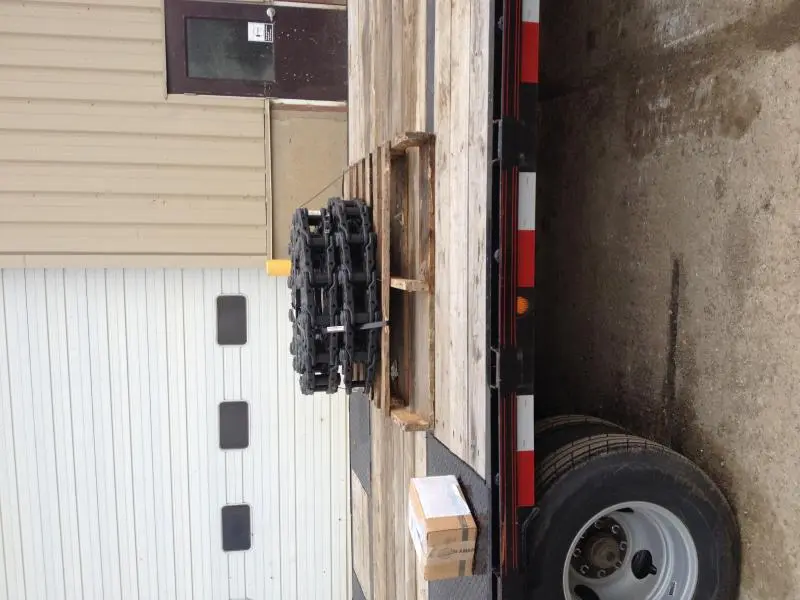You have to shim out the smaller diameter D3 rollers about 1-1/4" to replace the original D2 rollers. I think the D3 Tracks will fit straight in the old rollers if they are not too worn so the flanges hit the track link pin bosses.
The original tracks had hardening about 1/4" deep on the rails, so new is 3.00" and 100% worn is 2.75" high. That dimension coupled with the wear on the track rollers will determine whether the roller flanges cut into the pin bosses.
The newer track links were likely taller than 3" to start with and even a well worn set may still be tall enough to run for a while.
A more immediate problem may be the wear on pins and bushings that puts the front idlers too far forward in the track frames before the tracks reach the proper tension. A link can be removed if necessary to return that dimension to normal though the tracks will still be a little "snakey ".
Of course the proper way to address this is to have the pins and bushings turned so different surfaces are in contact. This rotates the external worn surfaces to put less worn areas in contact with the sprocket teeth as well as internal surfaces of bushing and pins tonshorten the tracks back to near new length.
I am no expert on p&b turning either but as you say, turning both pin and bushing 180 degrees puts the less worn surfaces together AND puts them on the tension side of the interface.
So there is slack in there but it is toward the side where it would allow compression if that happens. The important effect is the tracks are shorter and the unworn/less worn external surfaces of the bushing are toward the sprocket teeth so it will take longer before the bushing cracks and breaks up.
The optimum point for a p&b turn is earlier than you might guess. This is determined by the whole assembly life cycle. If the bushings get too thin before turning, they may shatter during the pressing operations and endanger the operator etc.
If you look at the track link design you will see that when moving forward, as the bushing contacts the sprocket tooth on the bottom of the sprocket, it does not rotate against the tooth until it leaves the sprocket at the top. All the rotation is inside between pin and bushing until the link leaves the sprocket at the top. This puts the rotation against the sprocket at the point where there is the least tension.
Working in reverse, the rotation of the bushing against the sprocket tooth is still at the top but now the tension is on it as it rotates, so you get accelerated wear. Probably an experienced mechanic can determine what work the tractor has been doing by the relative wear on the bushing external surface.
Track chains are always in tension (pulling or stretching). Not compression (pushing or pressing). Forward or reverse doesnt make a difference for internal wear. So turning pins and bushes 180 degrees will put unworn internal surfaces where they will be holding tension pressure of links, and worn surfaces where there is no more pressure.
Imagine a wheel vehicle with no wheel bearings, just bushings. The spindle which is stationary would have just about all of its wear on the bottom, because the weight of the vehicle bears on the bushing through the bottom of the spindle. This isnt exactly the right example, the bushing turns with the wheel, so its wear would be evenly distributed.
So imagine the same wheeled vehicle, that just moved forward and back slightly, so the wheels turned maybe 1/4 turn back and forth. Spindle would wear on the bottom, bushing would wear on the part contacting the bottom of the spindle. So vehicle would sit lower and lower to the ground. Turn bothe the spindle and the bushing in the wheel 180 and the vehicle is back up and on unworn areas of the system.
Make sense?
Thanks,
Stewart
You'll still have "snaky" rails that run up on the roller flanges when turning or doing slope work, not worth the expense to turn them, put new rails on.

I bought my new rails from Glen Shuey at Roland Equipment in Bolingbrook Il $2300 for the chains and the nut and bolts.
Chuck C
I just heard back from a Cat dealer local to me. They quoted $1,393 per chain, or $3,467 for both chains and all the bolts, tax included. I will keep checking around at various equipment dealers, as the Cat price is not as good as the previous post. However, it is encouraging that they are still available at all. I just put two new tires on a D17 farm tractor last spring at close to $1,200 per tire. So new tracks at ~ $3,500 total, that will last for the next 50 years, isn't that far out of line. I would re-use my pads, which are worn but usable. I didn't ask the price of new pads, but I'm sure they ain't cheap.
I have had no luck on used tracks, although I'm sure there still must be a few out there hidden in some salvage yard somewhere.